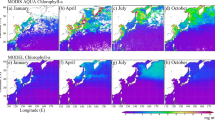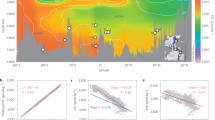Abstract
The air-sea flux of carbon is controlled by the disequilibrium in partial pressure of carbon dioxide between the atmosphere and surface ocean. This disequilibrium is a consequence of the interactions of physical, chemical and biological processes in the ocean and, today, includes a response to the anthropogenic increase of atmospheric pCO 2. Fig. 1 illustrates the annual mean airsea flux of carbon, F, estimated from a knowledge of the atmospheric partial pressure, pCO at2 and compilation of surface pCO 2 observations by Takahashi et al. (1999). The air-sea flux of carbon is determined by
where K 0 is the solubility of CO 2 at local temperature and salinity. K g is the air-sea gas transfer coefficient, which is dependent on local environmental conditions and is usually parameterized as a function of wind speed, sea-surface temperature and sea-surface salinity (Wanninkhof, 1992). The major global scale features in Fig. 1 are the outgassing of CO 2 from the tropical oceans, and the influx at mid and high latitudes. In this chapter we focus on understanding what sets the basin wide, and regional patterns of air-sea carbon flux in the North Atlantic basin. While we focus on the North Atlantic, some of the concepts and discussions are also relevent to other regions of the ocean.
Access this chapter
Tax calculation will be finalised at checkout
Purchases are for personal use only
Preview
Unable to display preview. Download preview PDF.
Similar content being viewed by others
References
Anderson, T. and I. Totterdell (2003) Modelling the response of the oceans biological pump to climate change. This volume.
Andersson, L.G. and A. Olsen (2002) Air-sea flux of anthropogenic carbon dioxide in the North Atlantic Geophys. Res. Lett., 29(19), 10.1029/2002GL014820.
Bates, N.R. (2000) Interannual Variability of Oceanic CO2 and Biogeochemical Properties in the Western North Atlantic Subtropical Gyre Deep-Sea Research II, 48, 1507–1528.
Bates N.R., A. C. Pequignet, R. J. Johnson and N. Gruber (2002) A Variable Sink for Atmospheric CO 2 in Subtropical Mode Water of the North Atlantic Ocean, Nature, 420, 489–493.
Broecker, W. S., Peng, T- H., (1974). Gas exchange rates between air and sea. Tellus, 26, 21–35.
Brostrom, G. (1997) Air-sea flux of CO 2 — can we shortcut the annual cycle? A Norwegian Sea case study. Phys. Chem. Earth, 21, 517–522.
Brostrom, G. (2000) The role of annual cycles for the air-sea exchange of CO 2. Marine Chem., 72, 151–169.
Cipollini, P., D. Cromwell, P.G. Challenor and S. Raffaglio, (2001). Rossby waves detected in global ocean colour data. Geophys. Res. Lett., 28, 323–326.
Conkright, M.E., R.A. Locarnini, H.E. Garcia, T.D. O’Brien, T.P. Boyer, C. Stephens, J.I. Antonov (2002) World Ocean Atlas 2001: Objective analyses, Data Statistics and Figures. CD-ROM Documentation. National Oceanographic Data Center, Silver Spring, Maryland.
Dickson, R., J. Lazier, J. Meinke, P. Rhines and J. Swift (1996) Long term coordinated changes in the convective activity of the North Atlantic. Prog. Oceanogr., 38, 241–295.
Emerson, S., P. Quay, D. Karl, C. Winn, L. Tupas, and M. Landry (1997) The carbon pump in the Subtropical Pacific Ocean: Implications for the Global Carbon Cycle, Nature, 389, 951–954.
Follows, M. J., T Ito and J. Marotzke (2002) The ocean’s subtropical gyres and Atmospheric pCO2. Global Biogeochem. Cycles, 16, 1113, doi:10.1029/2001GB001786.
Follows, M.J., Williams, R.G., Marshall, J.C., (1996). The solubility pump of carbon in the subtropical gyre of the North Atlantic. J. Mar. Res., 54, 605–630.
Gruber, N., (1998). Anthropogenic CO 2 in the Atlantic Ocean. Glob. Biogeochem. Cycles, 12, 165–191.
Gruber, N., N.Bates, and C.D. Keeling (2002) Interannual variability in the North Atlantic Ocean carbon sink, Science, 298, 2374–2378.
Hanawa, K. and L.D. Talley (2001) Mode Waters. In Ocean Circulation and Climate: Observing and Modelling the Global Ocean, Eds. G. Siedler, J. Church and J. Gould, 373–387.
Hansell, D.A. and C.A. Carlson (1998) Deep ocean gradients in dissolved carbon concentrations. Nature, 395, 263–266.
Holfort, J., K.M. Johnson, B. Schneider, G. Siedler and D.W.R. Wallace, (1998) Meridional transport of dissolved inorganic carbon in the South Atlantic Ocean. Glob. Biogeochem. Cycles, 12, 479–499.
Hurrell, J.W., Y. Kushnir, M. Visbeck, and G. Ottersen (2003) An Overview of the North Atlantic Oscillation. in The North Atlantic Oscillation: Climate Significance and Environmental Impact J.W. Hurrell, Y. Kushnir, G. Ottersen, and M. Visbeck, Eds. Geophysical Monograph Series, 134, pp. 1–35.
Ito, T., and M.J. Follows (2003) Upper ocean control of the solubility pump of CO 2. J. Marine Res., accepted for publication.
Josey, S.A., E.C. Kent and P.K. Taylor, (1998). The Southampton Oceanography Centre (SOC) Ocean-Atmosphere Heat, Momentum and Freshwater Flux Atlas. Southampton Oceanography Centre, Reports 6, 3Opp.
Lee, M.-M. and R.G. Williams, (2000). The role of eddies in the isopycnic transfer of nutrients and their impact on biological production. J. Mar. Res., 58, 895–917.
Lefevre, N, A.J. Watson, A. Olsen, A. Rios, F. Perez, T. Johannessen, R. Bellerby, I. Skjelvan, (2003). A decrease in the sink for atmospheric CO 2 in the North Atlantic, To be submitted to Geophs. Res. Lett.
Levy, M., L. Memery and G. Madec, (1998). The onset of a bloom after deep winter convection in the northwest Mediterranean sea: mesoscale process study with a primitive equation model. J. Mar. Sys., 16, 7–21.
Levy, M., P. Klein and A-M. Treguier, (2001). Impact of sub-mesoscale physics on production and subduction of phytoplankton in an oligotrophic regime. J. Mar. Res., 59, 535–565.
Lewis, M.R. (1992) Satellite ocean color observations of global biogeochemical cycles. In Primary Productivity and Biogeochemical Cycles in the Sea. Ed. P.G. Falkowski and A.D. Woodhead, Plenum Press, New York.
Lundberg, L. and P.M. Haugan (1996) A Nordic Seas — Arctic Ocean Carbon Budget from Volume Flows and Inorganic Carbon Data. Global Biogeochem. Cycles, 10, 493–510.
Mahadevan, A. and D. Archer, (2000). Modelling the impact of fronts and mesoscale circulation on the nutrient supply and biogeochemistry of the upper ocean. J. Geophys. Res., 105, 1209–1225.
Mahadevan, A., M. Levy, and L. Memery (2002) Mesoscale variability of sea surface pCO2: What does it respond to? Global Biogeochem. Cycles, submitted.
Marshall, D., (1997). Subduction of water masses in an eddying ocean. J. Mar. Res., 55, 201–222.
Marshall, J.C., A.J.G. Nurser and R.G. Williams, (1993). Inferring the subduction rate and period over the North Atlantic. J. Phys. Oceanogr, 23, 1315–1329.
Marshall, J. and E Schott, (1999). Open-ocean convection: observations, theory and models. Rev. Geophysics, 37, 1, 1–64.
McGillicuddy, D.J. and A.R. Robinson, (1997). Eddy-induced nutrient supply and new production in the Sargasso Sea. Deep-Sea Res. I, 44, 1427–1449.
McGillicuddy, D.J., A.R. Robinson, D.A. Siegel, H.W. Jannasch, R. Johnson, T. Dickeys, J. McNeil, A.F. Michaels and A.H. Knap, (1998), New evidence for the impact of mesoscale eddies on biogeochemical cycling in the Sargasso Sea. Nature, 394, 263–266.
McKinley, G.A. (2002) Interannual variability of the air-sea fluxes of carbon and oxygen. Ph.D. thesis. Massachusetts Institute of Technology.
McKinley, G.A., M.J. Follows and J.C. Marshall (2003) Mechanisms of interannual variability of the air-sea flux of CO 2. Submitted to Global Biogeochem. Cycles.
Murray, J. (2003) Ocean carbonate chemistry. This volume.
Nurser, A.J.G. and J.W. Zhang, (2000), Eddy-induced mixed-layer shallowing and mixed-layer/ thermocline exchange. J. Geophys. Res., 105, 21851–21868.
Orr, J. (2002) Global Ocean Storage of Anthropogenic CO 2: Final Report. EC Environment and Climate Program.
Oschlies, A., (2002) Can eddies make ocean deserts bloom? Global Biogeochem. Cycles, 16, 1106, doi :10.1029/2001 GB 001830.
Sabine, C.L., R.M. Key, K. Johnson, F.J. Millero, J. Sarmiento, D. Wallace and C. Winn (1999) Anthropogenic CO2 inventory of the Indian Ocean, Global Biogeochem. Cycles, 13, 179–198.
Sarmiento, J.L., Murnane, R., Le Quere, C., (1995). Air-sea CO 2 transfer and the carbon budget of the North Atlantic. Phil. Trans. Roy. Soc. Lond., B348, 211–219.
Sarmiento, J.L., N. Gruber, M.A. Brzezinski, and J.P. Dunne (2003) High latitude controls of the global nutricline and low latitude biological productivity. Nature, in press.
Sathyendranath, S., R.S.A. Longhurst, C.M. Caverhill, and T. Platt, (1995). Regionally and seasonally differentiated primary production in the North Atlantic. Deep-Sea Res. I., 42, 1773–1802.
Schmitz, W.J. and M.S. McCartney, (1993). On the North Atlantic circulation. Rev. Geophysics., 31, 29–49.
Stumm, W. and J. J. Morgan (1996) Aquatic Chemistry. Third Edition. John Wiley and Sons., N.Y., 1022pp.
Takahashi, T., Olafsson, J., Goddard, J.G., Chipman, D.W., Sutherland, S.C., 1993. Seasonal variation of CO 2 and nutrients in the high-latitude surface oceans: a comparative study. Global Biogeochemical Cycles, 7, 843–878.
Takahashi, T., Wanninkhof, R.H., Feely, R.A., Weiss, R.F., Chipman, D.W., Bates, N., Olafsson, J., Sabine, C., Sutherland, S.C., (1999). Net sea-air CO 2 flux over the global ocean: An improved estimate based on the sea-air pCO 2 difference. Proceedings of the 2nd International Symposium CO 2 in the Oceans, Ed. Y. Nojiri, Center for Global Environmental Research, CGER-1037-’ 99, Tsukuba, Japan, 9–15.
Uz, B.M, J.A. Yoder and V. Osychny, (2001). Pumping of nutrients to ocean surface waters by the action of propagating planetary waves, Nature, 409, 597–600.
Volk T., and M.I. Hoffert (1985) Ocean carbon pumps: Analysis of relative strengths and efficiencies in ocean-driven atmospheric CO 2 changes. Geophys. Monogr., 32, 99–110.
Wallace, D.W.R., (2001). Storage and transport of excess CO 2 in the oceans: the JGOFS/WOCE Global CO 2 survey. In Ocean Circulation and Climate: Observing and Modelling the Global Ocean, Eds. G. Siedler, J. Church and J. Gould, 489–521.
Wanninkhof, R. (1992) Relationship between wind speed and gas exchange over the ocean. Journal of Geophysical Research, 97, 7373–7382.
Watson, A.J., P.D. Nightingale and D.J. Cooper, (1995) Modelling atmosphere-ocean CO2 transfer. Phil. Trans. Roy. Soc. Lond., B348, 125–132.
Williams, R.G., (2001). Ocean Subduction. In Encyclopedia of Ocean Sciences, Eds. J.H. Steele, K.K. Turekian and S. A. Thorpe, Academic Press, 1982–1992.
Williams R.G. and M.J. Follows, (2003). Physical transport of nutrients and the maintenance of biological production. In Ocean Biogeochemistry: a JGOFS synthesis. Ed. M. Fasham, Springer, pp. 19–51.
Williams, R.G., McLaren, A.J., Follows, M.J., (2000). Estimating the convective supply of nitrate and implied variability in export production over the North Atlantic. Global Biogeochem. Cycles, 14, 1299–1313.
Xu, Y-F. (1990) A Study of the Biogeochemical Cycle of CO 2 in the Ocean Using a Parcel Model. Ph.D. thesis. 160 pp. University of East Anglia, Norwich, U.K.
Author information
Authors and Affiliations
Editor information
Editors and Affiliations
Rights and permissions
Copyright information
© 2004 Springer Science+Business Media Dordrecht
About this paper
Cite this paper
Follows, M., Williams, R.G. (2004). Mechanisms Controlling the Air-Sea Flux of CO 2 in the North Atlantic. In: Follows, M., Oguz, T. (eds) The Ocean Carbon Cycle and Climate. NATO Science Series, vol 40. Springer, Dordrecht. https://doi.org/10.1007/978-1-4020-2087-2_7
Download citation
DOI: https://doi.org/10.1007/978-1-4020-2087-2_7
Publisher Name: Springer, Dordrecht
Print ISBN: 978-1-4020-2086-5
Online ISBN: 978-1-4020-2087-2
eBook Packages: Springer Book Archive




